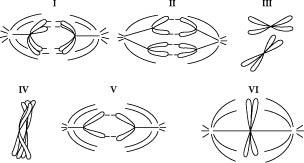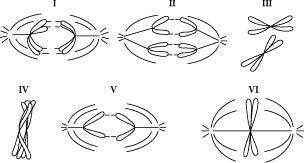Which of these is a karyotype?
Answers:
- a display of all of the cell types in an organism
- organized images of a cell’s chromosomes
- the appearance of an organism
- a display of a cell’s mitotic stages
2
Crossing over normally takes place during which of the following processes?
Answers:
- meiosis II
- meiosis I
- mitosis
- mitosis and meiosis II
2
Centromeres split and sister chromatids migrate to opposite poles in meiosis _____.
Answers:
- anaphase I
- telophase I
- anaphase II
- telophase II
3

Which diagram represents anaphase II of meiosis?
Answers:
- I
- III
- IV
- V
4
Which of the following defines a genome?
Answers:
- the complete set of an organism's polypeptides
- the complete set of a species' polypeptides
- a karyotype
- the complete set of an organism's genes and other DNA sequences
4
Which of the following is true of a species that has a chromosome number of 2n = 16?
Answers:
- The species is diploid with 32 chromosomes per cell.
- The species has 16 sets of chromosomes per cell.
- Each diploid cell has eight homologous pairs.
- A gamete from this species has four chromosomes.
3
Which of the following can occur by the process of meiosis but not mitosis?
Answers:
- Haploid cells fuse to form diploid cells.
- Haploid cells multiply into more haploid cells.
- Diploid cells form haploid cells.
- A diploid cell combines with a haploid cell.
3
If meiosis produces haploid cells, how is the diploid number restored for those organisms that spend most of their life cycle in the diploid state?
Answers:
- DNA replication
- reverse transcription
- synapsis
- fertilization
4
The human X and Y chromosomes _____.
Answers:
- are both present in every somatic cell of males and females
- are the same size and have the same number of genes
- include genes that determine an individual's sex
- are called autosomes
3
Sister chromatids separate from each other during _____.
Answers:
- meiosis I only
- meiosis II only
- mitosis and meiosis I
- mitosis and meiosis II
4
How do cells at the completion of meiosis compare with cells that are in prophase of meiosis I? They have _____.
Answers:
- half the number of chromosomes and half the amount of DNA.
- the same number of chromosomes and half the amount of DNA.
- half the number of chromosomes and one-fourth the amount of DNA.
- half the amount of cytoplasm and twice the amount of DNA.
3
Which of the following happens at the conclusion of meiosis I?
Answers:
- Homologous chromosomes of a pair are separated from each other.
- The chromosome number per cell remains the same.
- Sister chromatids are separated.
- Four daughter cells are formed.
1
Centromeres of sister chromatids disjoin and chromatids separate.
- Telophase II
- Anaphase I
- Telophase I
- Anaphase II
4
Homologous chromosomes are aligned at the equator of the spindle.
- Metaphase II
- Anaphase I
- Telophase I
- Metaphase I
4

Which diagram represents anaphase I of meiosis?
Answers:
- I
- II
- IV
- V
1
A given organism has 46 chromosomes in its karyotype. Therefore, we can conclude that it must _____.
Answers:
- be human
- be an animal
- reproduce sexually
- have gametes with 23 chromosomes
4
For the duration of meiosis I, each chromosome _____.
Answers:
- is paired with a homologous chromosome
- consists of two sister chromatids joined by a centromere
- consists of a single strand of DNA
- is joined with its homologous pair to form a synaptonemal complex
2
In meiosis, homologous chromosomes are separated during _____.
Answers:
- anaphase II
- prophase I
- mitosis
- anaphase I
4
Homologous chromosomes _____.
Answers:
- are identical
- carry information for the same traits
- carry the same alleles
- align on the metaphase plate in meiosis II
2
After telophase I of meiosis, the chromosomal makeup of each daughter cell is _____.
Answers:
- diploid, and the chromosomes are each composed of a single chromatid
- diploid, and the chromosomes are each composed of two chromatids
- haploid, and the chromosomes are each composed of a single chromatid
- haploid, and the chromosomes are each composed of two chromatids
4